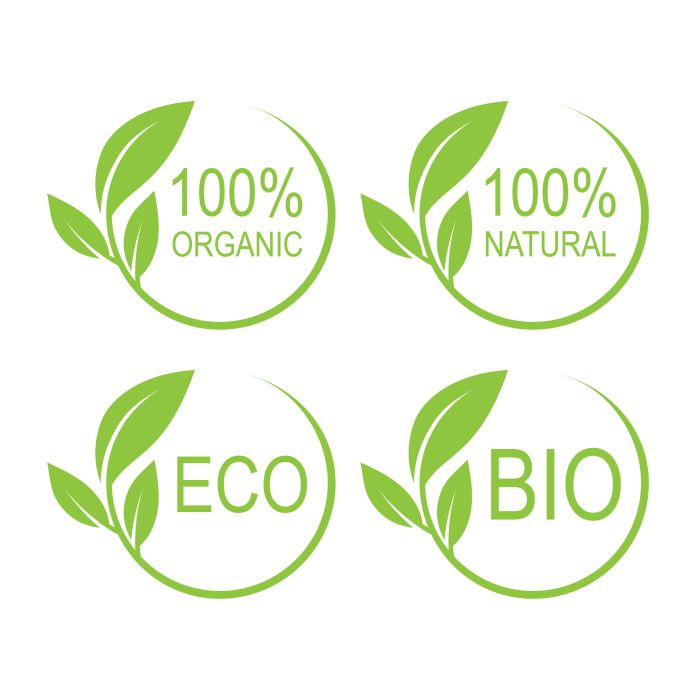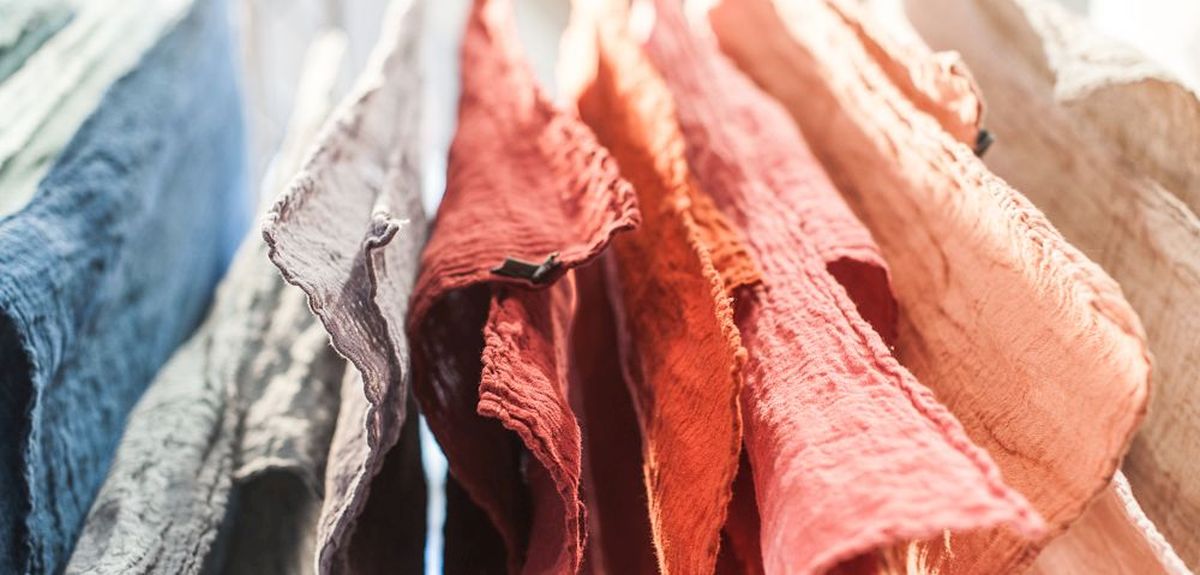
0% Dye By Couleur Chanvre
Did you know?
The dyeing and finishing phase of textiles really is a scandal and a major public health problem. Because the textile industry is one of the sectors which uses the largest number of toxic products that are dangerous to our health. We count tens of thousands of chemical molecules of which only a handful are documented, most of the time on the basis of evidence provided by the industry itself...only some of the molecules are banned and these bans often have exceptions. And what about products imported in the European Union? Millions of containers which arrive every day in our European ports, full of textile products coming from Asia or Northern Africa, avoiding all inspection, even if dangerous and highly toxic products have been used in their manufacture. Do not let yourself be fooled, even European production makes abundant use of products which bad for our health.Is there any point in talking about organic fabric?
Textile fibres - such as cotton - can be organic at the moment of its harvest by the farmer, but this can then be destroyed. Because, in the majority of cases, this organic cotton is filled with toxic chemical products during its textile transformation. And the fabric for sale will be presented to you like organic cotton, which makes no sense! This reality is complete nonsense, a bit like seasoning a beautiful organic tomato with a vinaigrette made of petrol...A real public health problem!
The array of chemical products used for textiles is very large - bleaching, dyeing, dye fixing, smoothing, softening, crease resistant, anti-stain agents, etc. Some of these can be very bad for your health because most of the industry’s chemical primers contain extremely dangerous molecules.The list is long but to start us off, we have taken 7 examples of products or categories of products which are bad for your health, are commonly used in the textile industry and which should be banned as quickly as possible!
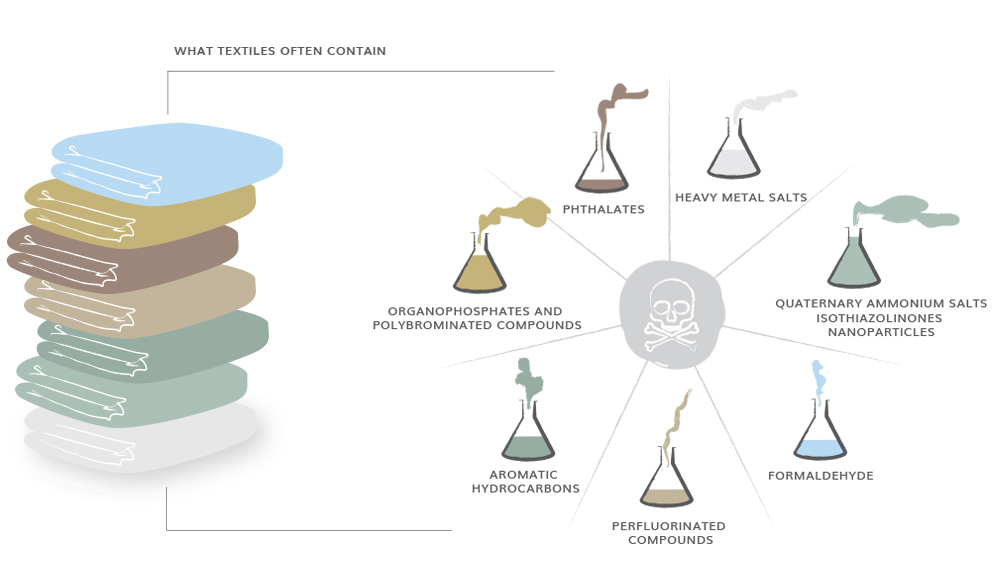
Aromatic hydrocarbons:
(ethoxylated nonylphenols, alkylbenzene, phenylene diamine, etc.)
detergents and chemical primers
potent endocrine disrupters, responsible for massive amounts of pollution
Phthalates:
Coating substances
Potent endocrine disrupters
Formaldehyde:
Chemical primers, fixers, printing ink
Group 3 carcinogen dyes
Quaternary ammonium salts, isothiazolinones, nanoparticles:
Primers, softeners
Potent allergenics
Perfluorinated compounds:
Primers and anti-stain substances
Carcinogenic products and products which are responsible for congenital malformations
Organophosphates and polybrominated compounds:
Flame retardants and other primers
Endocrine disrupters, neurotoxins and carcinogenic molecules
Heavy metal salts:
Dyes
Responsible for irreversible damage to our nervous and respiratory systems and for lung cancer.
(ethoxylated nonylphenols, alkylbenzene, phenylene diamine, etc.)
detergents and chemical primers
potent endocrine disrupters, responsible for massive amounts of pollution
Phthalates:
Coating substances
Potent endocrine disrupters
Formaldehyde:
Chemical primers, fixers, printing ink
Group 3 carcinogen dyes
Quaternary ammonium salts, isothiazolinones, nanoparticles:
Primers, softeners
Potent allergenics
Perfluorinated compounds:
Primers and anti-stain substances
Carcinogenic products and products which are responsible for congenital malformations
Organophosphates and polybrominated compounds:
Flame retardants and other primers
Endocrine disrupters, neurotoxins and carcinogenic molecules
Heavy metal salts:
Dyes
Responsible for irreversible damage to our nervous and respiratory systems and for lung cancer.
These products and many others have very serious consequences for people’s health. Studies show that they are endocrine disrupters, they create allergies, asthma and they can even affect the respiratory system, cerebral development and reproductive functions. Some of them are also possible carcinogens, verified or certain. But in the absence of effective measures, nothing changes. The European Chemicals Agency (ECHA), charged predominantly with enforcing the REACH regulations, with the goal of identifying and studying which chemical molecules are used, turns out to be ineffective and does not fulfil its initial promise of protecting our health. There are multiple reasons for this: it doesn’t have the means to work, but more often the information which would permit them to correctly evaluate molecules is not available to them. Furthermore, compromises and multiple exemptions that they have to give to the industries are in conflict with any opinions or instructions that they could adopt. In reality, businesses outside of the European Union are not obliged to follow the REACH regulations…
This situation really is very serious!
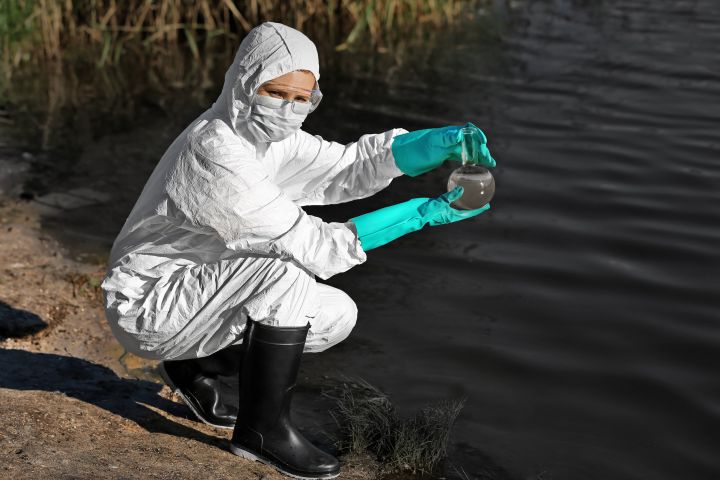
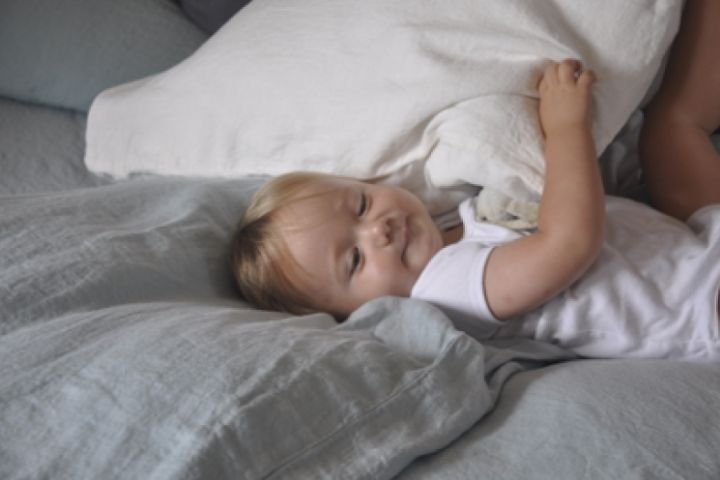
Particular spotlight on household linen
According to the calculations of the sociologist Jean Viard, we have a life expectancy of roughly 700,000 hours and we sleep between 200,000 and 250,000 hours, or about a third of our life. During all of this time, our skin, a very fragile organ, our airways and our mucous membranes have direct contact with our sheets, duvet covers and pillow cases and are poisoned through inhalation or touch if toxic residues are on the fabric. Some of these products are very tenacious and washing, even repeatedly, won’t make them disappear.What about labels?
Labels and certifications themselves are no guarantee because most of them authorise the use of products or ignore their effects, because they do have no more evidence than official bodies.
It should be noted that most “labels leurres” [dummy labels] which inundate the textile industry today, respond to marketing criteria rather than to our health and that of our children.
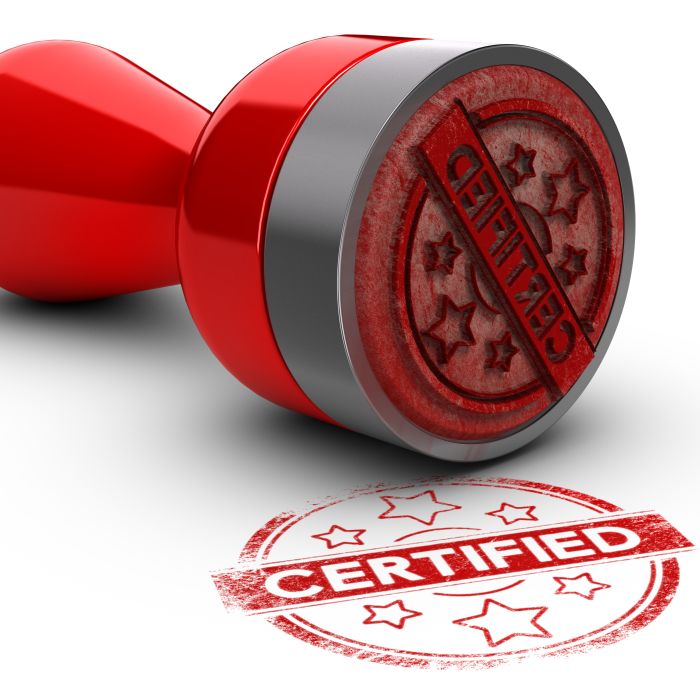
The planet suffers even more!
On this plain as well, the outcome is catastrophic, because the textile industry is the second global economic sector, but in terms of pollution and carbon footprint, it is probably the first.The textile industry emits more CO2 than aerial and marine transport combined (accord to the Ellen McArthur Foundation).
Auxiliary products from dyeing and other finishing products, like surfactants used in large qualities in the textile industry lead to a decrease in oxygen levels in the water and the accumulation of toxic products in living organisms (animal and vegetable) all along the food chain, leading to the extinction of certain specifies and the overgrowth of others. The quantity of aromatic hydrocarbons that are then dumped into our environment is equivalent to several oil spills annually, which are as dangerous as they are invisible. For example, certain experts consider than 90% of the destruction of the Mediterranean marine coast and forest results alone from surfactant agents…
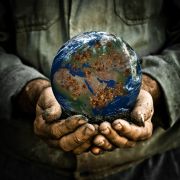
According to the World Bank’s estimate, close to 20% of the global industrial pollution of water comes from treating and dyeing textiles. Around 72 toxic chemical products end up in our water supply through the dyeing of textiles, a lot of which cannot be filtered or eliminated.
The suppliers of chemical products in this domain are largely responsible and play with words when they sell “organic” products - meaning up to 60% biodegradable - even though the 40% of compounds left are responsible for this pollution.
Transparency, traceability and reliability of information
If that is not serious enough, we could almost laugh at the words written on the ECHA (European Chemicals Agency) website, in the “Clothes and Textiles” tab under the chapter titled “Tips for Consumers”: (Where this is written: “Use your right to ask if the textiles you buy contain substances of very high concern above a certain limit.” Next time, ask the vendor of your chosen household linen this question…
Numerous progresses have to happen, urgently, in terms of production standards and the banning of dangerous products, but also in terms of transparency, traceability with complete and honest important which should be delivered
At the end of the day, it’s you who, as consumers, have the power to change that!
We at Couleur Chanvre demonstrate every day that alternative methods of production, which are safe for your health, ecological for the planet and ethical do exist! What’s more, our production is 100% French!
You should know that we are always at the forefront of this essential battle for your health and for our planet, even though we are fragile artisans facing powerful industries and retailers.
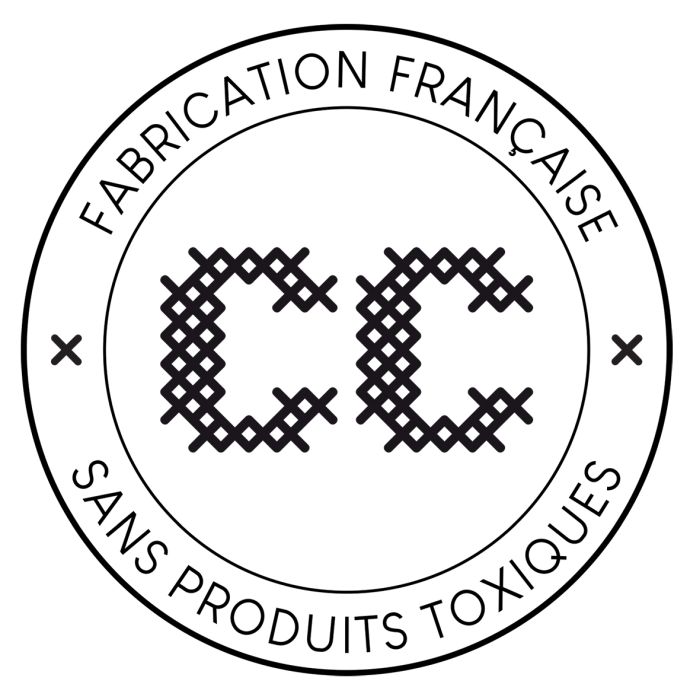
References:
http://www.asef-asso.fr/production/les-vetements-quand-les-toxiques-se-cachent-la-synthese-de-lasef/
https://www.ellenmacarthurfoundation.org/publications/a-new-textiles-economy-redesigning-fashions-future
http://www.cancer-environnement.fr/181-Formaldehyde.ce.aspx
http://www.fabricoftheworld.com/
https://cdn.greenpeace.fr/blog/uploads/2012/11/10-11_HD.jpg
https://cdn.greenpeace.fr/site/uploads/2017/02/Les-dessous-toxiques-de-la-mode_2012.pdf
https://storage.googleapis.com/planet4-international-stateless/2011/07/3da806cc-dirty-laundry-report.pdf
https://www.greenpeace.org/eastasia/Global/eastasia/publications/reports/toxics/2011/Dirty%20Laundry%202.pdf
https://chemicalsinourlife.echa.europa.eu/fr/clothes-and-textiles/
https://chemicalsinourlife.echa.europa.eu/substances-we-dont-want-in-our-clothes
https://echa.europa.eu/fr/support/guidance-on-reach-and-clp-implementation/identify-your-obligations/navigator/-/navigator/help/help_002_role
https://www.anses.fr/fr/search/site/textile?iso1=fr&iso2=en


